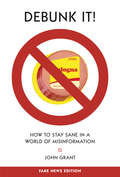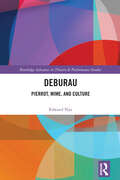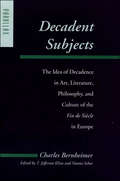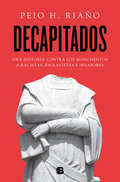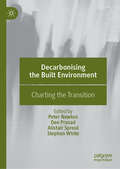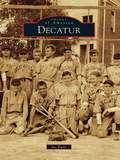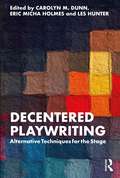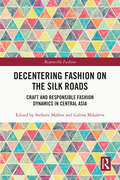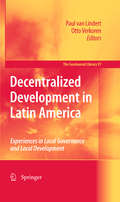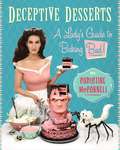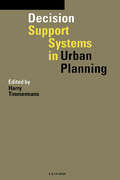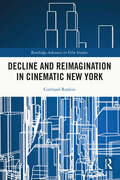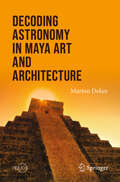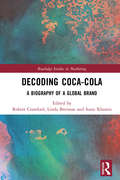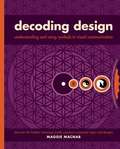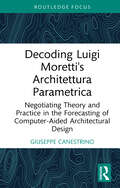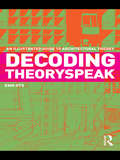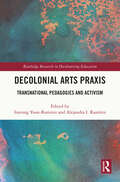- Table View
- List View
Debunk It! Fake News Edition: How to Stay Sane in a World of Misinformation
by John GrantWe live in an era of misinformation, much of it spread by authority figures, including politicians, religious leaders, broadcasters, and, of course, apps and websites. In this second edition, author John Grant uses ripped-from-the-headlines examples to clearly explain how to identify bad evidence and poor arguments. He also points out the rhetorical tricks people use when attempting to pull the wool over our eyes, and offers advice about how to take these unscrupulous pundits down. Updated to include a chapter on fake news, Debunk It serves as a guide to critical thinking for young readers looking to find some clarity in a confusing world.
Deburau: Pierrot, Mime, and Culture (Routledge Advances in Theatre & Performance Studies)
by Edward NyeThis volume analyses the nature of the mime art of Deburau and of the pantomime performances of the Théâtre des Funambules in Paris in the context of Romantic art, literature and socio-political thought. Deburau and the Théâtre des Funambules are characteristic of Romantic art in that they are closely associated with certain aspirations for social reform, even revolution. Deburau was an iconic figure for intellectuals such as George Sand who effectively considered him to be part of the ‘poète-maçon’ movement. Edward Nye examines this fascination as well as the myth which developed from it. With its unique framing in art, literature and politics, this book is a must read for undergraduates and postgraduates in theatre, literary studies, and the Romantic period.
Decadent Subjects: The Idea of Decadence in Art, Literature, Philosophy, and Culture of the Fin de Siècle in Europe (Parallax: Re-visions of Culture and Society)
by Charles BernheimerHonorable Mention for the Aldo and Jeanne Scaglione Prize for Comparative Literary Studies from the Modern Language AssociationCharles Bernheimer described decadence as a "stimulant that bends thought out of shape, deforming traditional conceptual molds." In this posthumously published work, Bernheimer succeeds in making a critical concept out of this perennially fashionable, rarely understood term.Decadent Subjects is a coherent and moving picture of fin de siècle decadence. Mature, ironic, iconoclastic, and thoughtful, this remarkable collection of essays shows the contradictions of the phenomenon, which is both a condition and a state of mind. In seeking to show why people have failed to give a satisfactory account of the term decadence, Bernheimer argues that we often mistakenly take decadence to represent something concrete, that we see as some sort of agent. His salutary response is to return to those authors and artists whose work constitutes the topos of decadence, rereading key late nineteenth-century authors such as Nietzsche, Zola, Hardy, Wilde, Moreau, and Freud to rediscover the very dynamics of the decadent. Through careful analysis of the literature, art, and music of the fin de siècle including a riveting discussion of the many faces of Salome, Bernheimer leaves us with a fascinating and multidimensional look at decadence, all the more important as we emerge from our own fin de siècle.
Decapitados: Una historia contra los monumentos a racistas, esclavistas e invasores
by Peio H. Riaño¿Es lícito acabar con la propaganda de genocidas, dictadores, esclavistas, invasores y otros personajes tan deleznables en el espacio público? Este ensayo provocador y fascinante demuestra por qué es hora de retirar los homenajes que ofenden a la ciudad progresista. Ya en la Roma clásica la destrucción de monumentos y símbolos era una forma de borrar de la historia a los enemigos que habían sido derrotados. En épocas más recientes, esta práctica ha adquirido otro significado las estatuas de Colón, Lenin o Sadam Husein han sido expulsadas de los lugares donde una vez se alzaron , convirtiéndose en una reivindicación por el respeto a la nueva ciudadanía que no quiere esa carga. El historiador del arte y periodista Peio H. Riaño aborda un debate en auge que se pregunta cómo queremos que sea la ciudad del siglo XXI, mientras el movimiento Black Lives Matter protesta contra los símbolos racistas y en Latinoamérica miles de personas se manifiestan pidiendo la desaparición de los conquistadores de bronce y piedra que aún adornan sus calles. A través de un recorrido por una serie de representaciones «artísticas», desde Mao hasta Franco, esta investigación cultural cuestiona que se deban conservar los monumentos que representan valores insoportables como el racismo, el machismo y la exclusión. El resultado es un texto polémico y erudito, que nos demuestra por qué la decapitación de estos monumentos no pretende depurar la historia, como algunos sostienen, sino limpiar el presente con la verdad histórica y extirpar los elementos que tergiversan la lectura del pasado.
Decarbonising the Built Environment: Charting the Transition
by Stephen White Alistair Sproul Peter Newton Deo PrasadThis book focuses on the challenge that Australia faces in transitioning to renewable energy and regenerating its cities via a transformation of its built environment. Both are necessary conditions for low carbon living in the 21st century. This is a global challenge represented by the United Nation’s Sustainable Development Goals and the IPCC’s Climate Change program and its focus on mitigation and adaptation. All nations must make significant contributions to this transformation. This book highlights the new knowledge and innovation that has emerged from research projects undertaken in the Co-operative Research Centre for Low Carbon Living between 2012 and 2019 – an initiative of the Australian Government’s Department of Industry, Science and Technology that is tasked with responding to the UN challenges. Four principal transition pathways were central to the CRC and provide the thematic structure to this volume. They focus on technology, buildings, precinct and city design, and human behaviour – and their interactions.
Decarbonization of Cities in Asia: A Polycentric Approach to Policy, Business and Technology
by Vincent S. Cheng Guo-Jun LiThis book provides best practices for decarbonizing cities in East Asia, in which buildings are the major contributor to carbon emissions. Beyond the global commitment through the Paris Agreement to make collective efforts on climate action and accelerated policies, investment and development at the country and city level to combat climate change are occurring at an unprecedented rate. Rapid urbanization and increasing energy demand for large and dense Asian cities require smart and sustainable strategies to balance development with decarbonization. A poly-centric approach is needed, where a combination of policy-, market- and technology-driven changes can aid the transition towards development of carbon neutral cities. With practical examples in the implementation of the United Nations Sustainable Development Goals, green financing, climate action roadmap and policy, deployment of renewable energy, and low- to zero-carbon buildings, readers can find the motivation, considerations and implementation pathways to facilitate the transition into the new normal. It is the hope of the authors to encourage readers to see successful pathways in transitioning into a carbon-free industry and overcoming the effects of climate extremes.
Decarbonization or Demise – Sustainable Solutions for Resilient Communities: Selected Papers from the International Conference of Sustainable Ecological Engineering Design for Society (SEEDS) 2023
by Beth Jones Mohammad Dastbaz Christopher Gorse Colin Booth Lloyd Scott Darryl Newport Saheed Ajayi Leonie ParkinsonThe International Conference for Sustainable Ecological Engineering Design for Society (SEEDS) brings together experts from around the world to focus on changes required to minimize the impact of human activity on the environment. The research presented at the conference directly addresses the imperatives faced in addressing the climate crisis, whether through technological transformation, community collaboration, or resource management – all vital issues when changing and challenging practices within our built environment. The SEEDS Conference is designed to share the knowledge and experience needed to implement research and evidence-based societal change to respond to and address ecological and climate impacts.
Decarbonize Public and Commercial Buildings: China Building Energy and Emission Yearbook 2022
by Tao Zhang Xiaohua Liu Yi Jiang Shan Hu Qingpeng WeiOne of the key motivations and goals for China's social and economic development is the dual carbon target. Building is one of the most important sectors to reduce emissions and save energy, accounting for more than 20% of China's primary energy consumption and carbon emissions. This book analyzes the energy consumption of China's buildings sector in four categories, their characteristics and technologies to improve energy efficiency, and examines the greenhouse gas emissions of China's buildings, including building construction embodied emission and building operation emissions. In particular, this book discusses the ways to achieve carbon neutrality targets for China's public and commercial building sectors. This book also analyzes the energy mix, energy intensity, and technological prospects for achieving energy and carbon targets in the public and commercial building sectors. This book contains a large amount of survey data, monitoring data, and case studies. The debate on technologies and policies is underpinned by a variety of evidence and research that has been ongoing for more than a decade. The information, data, and policy recommendations will be of interest to a national and international audience working in the fields of energy, climate change, engineering, and building science.
Decatur (Images of America)
by Joe EarleDecatur proudly proclaims itself a city of "homes, schools, and places of worship." While that motto might seem to describe any number of small towns, the words accurately capture the essence of Decatur, a place of fine and humble homes, well-regarded schools, and large, active churches. Founded by the Georgia legislature in 1823 to be the county seat of DeKalb County, Decatur took its name from Commodore Stephen Decatur, a U.S. naval hero of the early 1800s. In the years since, Decatur has grown into a busy suburb of neighboring Atlanta, produced Agnes Scott College, and attracted both the Scottish Rite Children's Hospital and Columbia Theological Seminary. Decatur has been home to fascinating Georgians, including Civil War memoirist Mary Gay and writer Rebecca Latimer Felton, the first woman to be seated as a U.S. senator (if only for a day).
Decatur: 1832-1945 (Images of America)
by Dan GuilloryDecatur, Illinois has long had a proud tradition of workers and craftsmen who produced coal, water pumps, gloves, automobiles, clothing, corn meal, and many other products. Though it is home to Caterpillar's second largest plant and serves as world headquarters for Archer Daniels Midland, a global processor of corn and soybeans, Decatur is much more than jobs and factories. If Illinois is the Heartland, then Decatur is the Heart of the Heartland. Decatur is the site of Abraham Lincoln's first Illinois residence, in 1830, and it is where he was nominated for the presidency on May 10, 1860. Decatur is also home to a symphony orchestra, homes designed by Frank Lloyd Wright, a community college, and Millikin University.
Decent Homes for All: Planning's Evolving Role in Housing Provision (Housing, Planning and Design Series)
by Nick Gallent Mark Tewdwr-JonesAre you concerned about the state of current housing provision? Worried about further decline in the years ahead? Decent Homes for All addresses fundamental questions about the current housing crisis; examining its history and evolution. The first text on the housing-planning interface, it explores the relationship between planning and housing supply, focusing on housing supply, the quality and form of residential development, affordability and sustainability and the changing nature of planning itself. The questions covered include: Why have we moved away from state housing provision? How might the current crisis in housing affordability be addressed through planning policy? Why has recent debate broadened to encompass the idea of ‘sustainable communities’? How will we deliver quality, affordable housing in the future? What role should the planning system play in delivering decent homes in the years ahead? This comprehensive narrative provides students, planners and researchers with a valuable account of the evolving relationship between planning and housing to aid contextual understanding and suggest how current issues might evolve in the future.
Decentered Playwriting: Alternative Techniques for the Stage
by Carolyn M. DunnDecentered Playwriting investigates new and alternative strategies for dramatic writing that incorporate non-Western, Indigenous, and underrepresented storytelling techniques and traditions while deepening a creative practice that decenters hegemonic methods. A collection of short essays and exercises by leading teaching artists, playwrights, and academics in the fields of playwriting and dramaturgy, this book focuses on reimagining pedagogical techniques by introducing playwrights to new storytelling methods, traditions, and ways of studying, and teaching diverse narratological practices. This is a vital and invaluable book for anyone teaching or studying playwriting, dramatic structure, storytelling at advanced undergraduate and graduate levels, or as part of their own professional practice.
Decentering Fashion on the Silk Roads: Craft and Responsible Fashion Dynamics in Central Asia (Responsible Fashion)
by Stefanie Mallon Galina MihalevaDecentering Fashion on the Silk Roads focuses on the dynamism of fashion, textile craft, heritage, and sustainability in Central Asia and beyond. The compelling series of accounts provides a comprehensive set of insights and impressions collected from both fashion academics, designers and practitioners from around the globe who journeyed through Uzbekistan and Kazakhstan and from those who live and work in this region. It showcases ways in which local textile craft practices can inform the modern fashion industry into becoming more sustainable.The book opens by exploring the importance of the old ‘Silk Roads’ crossing through the heart of the world in Central Asia, serving not only as trade routes but also allowing knowledge, art, and practices to be transmitted between the Orient and the Occident – enabling ideas to flourish and cultural dispositions to develop from Antiquity until Modernity. The unique set of chapters that follow examine and highlight the growing opportunities and lessons this region has to offer to Western fashion through local artistry and craft, and points toward the urgent need to slow down and adopt responsible principles and practices. The book constitutes a warm appreciation of the experiences and grateful thanks to the many communities from all different backgrounds and ages who contributed.This rich travelogue is a refreshing resource for international scholars and postgraduate students studying and researching fashion theory and management in particular. It will also be of interest to anthropologists, cultural studies, and textiles scholars.
Decentralized Development in Latin America
by Paul Lindert Otto VerkorenThe Latin American subcontinent appears to have reinvented itself in the 21st century. Its economy has been transformed under liberalization and globalisation. Decentralization and the democratic transition have modified the political environment, while local development approaches are replacing the (grand) national-regional development schemes. The current local governance and local development debates refer to very different levels of scale: from small, rural communities to fairly extensive (even international) spaces. It is clear that the development process shows substantial differences between large and small cities, and between core regions and remote rural areas. Indeed, the heterogeneity of the process is strongly influenced by national, regional and local contexts. The empirical studies in this volume show the diversity and complexity of local governance and local development in Latin America, while avoiding stereotypes about the impact of public sector reform and administrative decentralization.
Deceptive Desserts
by Christine McconnellInternet star Christine McConnell bakes, decorates, sews, and styles it all . . . with a twist--now she shows you how to do it on a shoestring budget.Photographer and stylist Christine McConnell transforms the ordinary into the extraordinary--from everyday dinners, to desserts for all occasions, to the walls of your kitchen, and even some over-the-top creations just for fun. Taking inspiration from the likes of Tim Burton, Alfred Hitchcock, and Vincent Price and mixing in a dash of Stepford Wife, McConnell's baking and home DIY projects are a league above and beyond anything you've seen before. In Deceptive Desserts each dessert is a work of art--some a little twisted, others magical--but every recipe inspires readers to create their own rules without spending a fortune. Why can't crab cakes be a delicious pink-frosted dessert? And if you're stuck hosting a bridal shower, why not create an actual Bridezilla cake to match the bride's ego? Nothing is sacrosanct in the wonderfully weird world of Christine McConnell and nothing it what it appears to be--even a classic dinner can be transformed into something decadent, with doughnuts that look like chicken drumsticks, green beans made of candy, and ice cream mashed potatoes. A master of illusions in baking, McConnell shows readers how to create their own secret hidden gems in the kitchen. In her follow-up book McConnell will go outside the kitchen to show readers how to incorporate magic and fantasy into their home decor and personal style without breaking the bank. Using the renovations of her own house as a guide, McConnell walks readers through easy DIY projects such as hand-painted wallpaper, refinishing wood and tile floors, and adding storage space, along with inexpensive decorating tips. A dazzling collection of photographs, stories revealing her one-of-a-kind character, and helpful tricks for doing it all yourself, McConnell's book will inspire readers to be more playful, and just a little bit wicked, with the food they create and the space they inhabit.
Decision Support Systems in Urban Planning
by Harry TimmermansThis book presents a set of selected and edited papers presented at the 2nd and 3rd Design and Decision Support Conference. The purpose is to provide examples of innovative research in decision support systems in urban planning from throughout the world.
Decline and Reimagination in Cinematic New York (Routledge Advances in Film Studies)
by Cortland RankinDecline and Reimagination in Cinematic New York examines the cinematic representation of New York from the mid-1960s through the mid-1980s, placing the dominant discourse of urban decline in dialogue with marginal perspectives that reimagine the city along alternative paths as a resilient, adaptive, and endlessly inspiring place. Drawing on mainstream, independent, documentary, and experimental films, the book offers a multifaceted account of the power of film to imagine the city’s decline and reimagine its potential. The book analyzes how filmmakers mobilized derelict space and various articulations of “nature” as settings and signifiers that decenter traditional understandings of the city to represent New York alternately as a desolate wasteland, a hostile wilderness, a refuge and playground for outcasts, a home to resilient and resourceful communities, a studio for artistic experimentation, an arcadia conducive to alternative social arrangements, and a complex ecosystem. This book will be of interest to scholars and students of film studies, media studies, urban cinema, urban studies, and eco-cinema.
Decoding Astronomy in Maya Art and Architecture (Springer Praxis Books)
by Marion DolanThe exciting discoveries and newest revelations in the field of archeoastronomy present fascinating examples of the importance of astronomy to the ancient Maya Civilization. Through technological advancements made in the archeoastronomy community, this book will allow you to uncover a time capsule from an ancient past. In a clear and comprehensible manner you will read about art and architecture from various important Maya cities, drawn from diverse time periods and from different geographical areas of Mesoamerica. The topics covered include new findings in wide variety of fields; including the history's of astronomy, science, art, architecture, literature and religion. You will explore in this book how the motions of the heavens were closely watched and notated by Maya astronomers and how those celestial objects determined the patterns of everyday life, religious rites, community festivals, agriculture, even birth and death! This book will open your mind to a deeper awareness and an even greater admiration for the Maya ingenuity in preserving their astronomical knowledge and passing it on to assist future generations. These latest findings will broaden our perception of the Maya cultures of the Pre-classic and their development through the Classic period and the remarkable changes that occurred throughout their 3000 years of history.
Decoding Coca-Cola: A Biography of a Global Brand (Routledge Studies in Marketing)
by Robert CrawfordThis collection of essays delves into the Coke brand to identify and decode its DNA. Unlike other accounts, these essays adopt a global approach to understand this global brand. Bringing together an international and interdisciplinary team of scholars, Decoding Coca-Cola critically interrogates the Coke brand as well its constituent parts. By examining those who have been responsible for creating the images of Coke as well as the audiences that have consumed them, these essays offer a unique and revealing insight into the Coke brand and asks whether Coca-Cola is always has the same meaning. Looking into the core meaning, values, and emotions underpinning the Coca-Cola brand, it provides a unique insight into how global brands are created and positioned.This critical examination of one of the world’s most recognisable brands will be an essential resource for scholars researching and teaching in the fields of marketing, advertising, and communication. Its unique interdisciplinary approach also makes it accessible to scholars working in other humanities fields, including history, media studies, communication studies, and cultural studies.
Decoding Design
by Maggie Macnab* The DaVinci Code phenomena has generated popular interest in symbology and the meanings of shapes, numbers and symbols* The book integrates design with other disciplines and genres, such as philosophy, math and physics, for a holistic and wordly presentation of ideas. It will be very useful in design curriculums. Our complex world is comprised of a handful of some very simple patterns. Patterns are made of basic shapes. These shapes have found their way into human design since the beginning of our time because they tell an eternal tale in a glimpse and their structure instructs about our connection to the universe. Symbols are intuitive and immediate. Design that references these symbols creates an immediate relationship with the viewer and that is what this book is all about. Decoding Design reveals how common symbols resonate at a gut level. Readers will find deconstructions of famous logos and examples of variety of different designs that effectively use symbols, patterns and shapes to convey greater meaning.
Decoding Design
by Maggie MacnabUnderstand the Significance of Symbols in Your Design WorkOur world is comprised of a handful of very simple patterns that have been a part of human design since the beginning of time and have eternal significance.Decoding Design reveals how common symbols and shapes - like circles, squares and triangles - resonate at a gut level and can lend greater meaning to a design. By deconstructing famous logos and other sample designs, you'll learn how to communicate complex information quickly and intuitively with universal and meaningful patterns. You'll also uncover how other disciplines, such as philosophy, math, and physics, influence great design and can help you present ideas in a holistic and compelling manner.Whether you're a designer, student, or marketing professional, Decoding Design will show you the deeper meaning behind the symbols you encounter everyday, and how to better use those symbols to create an impactful relationship with the viewer.
Decoding Luigi Moretti's Architettura Parametrica: Negotiating Theory and Practice in the Forecasting of Computer-Aided Architectural Design
by Giuseppe CanestrinoDecoding Luigi Moretti’s Architettura Parametrica presents an unprecedented critical discussion of one of the earliest theoretical and practical explorations into the integration of scientific thought, mathematical models, and digital tools in architectural design. Moretti, a renowned professional who engaged in countless intellectual initiatives, developed and refined his architectural vision long before “parametric” became synonymous with computational design. His Architettura Parametrica is an unconventional inquiry of the prospects offered to design practice by digital thinking rather than by digital tools, which were still immature or completely absent at the time. Moretti proposed a unique and still relevant mental landscape that united his fascination with Baroque spatiality, operational research, informal art, optics, cybernetics, ethics, and much more. This research decodes numerous facets of Architettura Parametrica, from the rigid theoretical precepts to the negotiation with design praxis, from the use of equations to aid the research of forms to the speculation on the meaning of architecture through abstract mathematics.This book offers novel perspectives to scholars interested in the interplay between architectural design practice and theory, mathematics and design methods, digital and architectural culture, and to the growing number of practitioners who are crafting personal narratives within the most disruptive computational techniques.
Decoding Theoryspeak: An Illustrated Guide to Architectural Theory
by Enn OtsExistentialism; Urbanism; Aporia; Deontic; Tabula Rasa; Hyperspace; Heterotopia; Metareality; Structuralism… What does it all mean? The unique language used in architectural theory – both in speech and writing – can appear daunting and confusing, particularly to new architectural students. Decoding Theoryspeak provides an accessible guide to the specialized language of contemporary design for the next generation of thinkers, architects and design leaders. It includes: definitions of over 200 terms clear cross-references illustrations throughout. It is an essential pocket-sized resource for students and practitioners alike.
Decolonial Arts Praxis: Transnational Pedagogies and Activism (Routledge Research in Decolonizing Education)
by Injeong Yoon-Ramirez Alejandra I. RamírezDecolonial Arts Praxis: Transnational Pedagogies and Activism illustrates the productive potential of critical arts pedagogies in the ongoing work of decolonization by engaging art, activism, and transnational feminisms. Offering contributions from scholars, educators, artists, and activists from varied disciplines, the volume highlights how arts can reveal intersectional forms of oppression, inform critical understandings, and rebuild transnational solidarities across geopolitical borders. The contributors present forms of enquiry, creative writing, art, and reflection which grapple with issues of colonialism, racism, and epistemological violence to illustrate the power of decolonial arts pedagogies in formal and informal education. Using a range of multiple and intersectional critical lenses, through which readers can examine ways in which transnational feminist theorizing and art pedagogy inform, shape, and help strategize activism in various spaces, it will appeal to scholars, postgraduate students, and practitioners with interests in arts education, the sociology of education, postcolonialism, and multicultural education.
Decolonial Imaginaries in Palestinian Experimental Film and Video: Postnational and Feminist Aesthetics (Routledge Focus on Film Studies)
by Kristin Lené HoleDecolonial Imaginaries in Palestinian Experimental Film and Video focuses on an underexamined group of female Palestinian filmmakers, highlighting their relevance for thinking through a diverse set of issues relating to decolonial aesthetics, post-nationalism and gender, non-Western ecologies, trauma and memory, diasporic experiences of space, biopolitics, feminist historiography and decolonial temporalities.Positing that these filmmaker-artists radically counter dominant media images of Palestinians, deessentializing Palestinian identity while opening up history and the present to new potentialities and ways of imagining Palestinian futures, Decolonial Imaginaries in Palestinian Experimental Film and Video argues that Palestinian experience is urgently relevant to all of us. As the works address issues of food availability and land use, environmental collapse and forced displacement, Hole explores how such films generate hope, imagine impossible possibilities and offer inspiration and wisdom when it comes to losing and rebuilding.Addressing a fundamentally transnational and understudied area, this book will resonate with readers working in the areas of film and media studies, Palestinian cultural studies, historiography, Middle East studies and experimental film.
